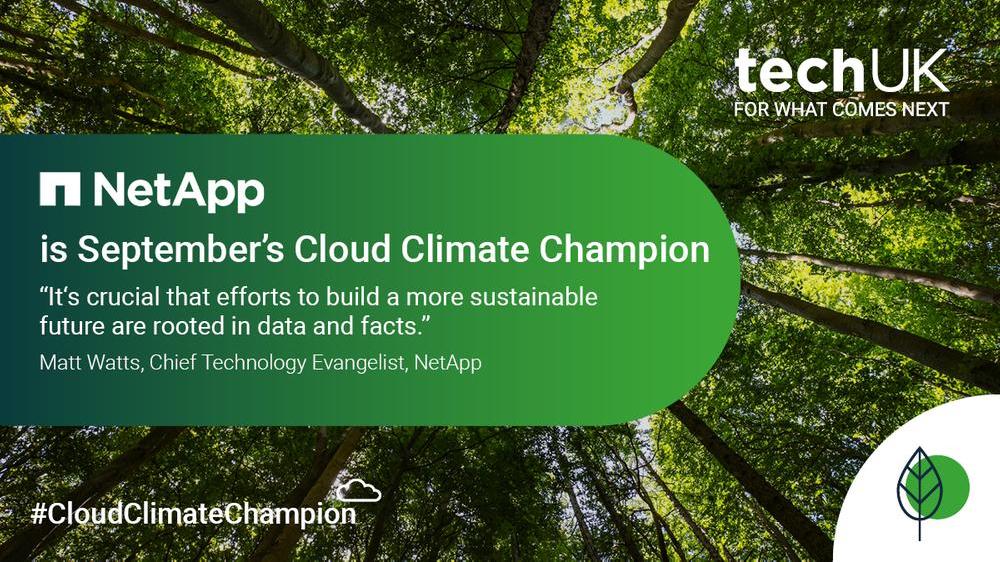How organisations (and the planet) can benefit from a sustainable cloud environment (Guest blog from NetApp)

Author: Matt Watts, Chief Technology Evangelist at NetApp
Have you thought about the environmental impact of your digital existence?
Our digital actions have real world consequences: whether sending an email, streaming content, or spinning up a new development environment, your online activities go beyond the virtual. In fact, the environmental impact is likely to shock you – though by thinking about how and when we use technology, we can all do our bit for the planet.
However, beyond the individual, there is a bigger opportunity for good here that infrastructure providers can seize. Cloud storage can benefit the environment and as the world’s data volumes continue to grow, the need for it to be stored in a sustainable manner grows too.
If you can't monitor it you can't manage it
We are creating a giant landfill of data that’s sat on devices that are consuming power. A landfill that is costing organisations millions, and creating emissions.
As we said, every action in the digital world has an impact on the environment; the consequences of which are often out of sight and out of mind. Many will have seen footnotes in emails with reminders of the environmental consequences of printing them or their attachments, but have many people considered the actual consequences of sending emails? The average email creates around 0.5g of carbon dioxide and with attachments this can eclipse 10-20g of carbon dioxide - that email with many large attachments now seems far less sustainable, doesn’t it? Even limiting the number of people an email is sent to has a positive impact (and they are likely to thank you too).
So, what about infrastructure? The good news is that the technology companies who provide the infrastructure foundations for today’s data have an opportunity to work for the better of the people and planet, to reduce the environmental impact of data for good. By creating the tools to help people manage their data more effectively, tech organisations can make their environments greener and more sustainable for the future.
More focus needs to go into what is inside the data centre, not just the physical equipment but also in terms of digital wastage. A good example is that data storage devices are responsible for up to 20% of data centre power consumption, however estimates show that around 70% of the data created and stored is never used again. We are creating a giant landfill of data that’s sat on devices that are consuming power. A landfill that is costing organisations millions, and creating emissions.
Companies also need to accelerate their plans to work with the Hyperscale providers, Azure, AWS and GCP. These providers are building some of the world’s most efficient data centres, and are making extremely rapid progress towards becoming net zero. For most organisations, data and workloads that can be relocated to the public cloud will deliver a positive reduction in emissions.
Working out ways to better manage this holds real opportunity and is a big focus for companies like NetApp as we try to provide data centre operators with more advanced data analytics to help them to make better decisions about what to do with the data they are storing.

Data isn’t disappearing from our lives, so we need to make it part of our sustainable global future.
It's time to have a conversation about data and sustainability
By 2025, Statista forecasts a global datasphere of 180ZB (zettabytes). And if data is growing, so too is power consumption. Further research, this time commissioned as part of the World Economic Forum’s 2030 Vision, found that 70% of the 169 UN Sustainable Development Goal (SDG) targets can be directly supported by advanced technologies, so technology and data can really to help the most pressing challenges faced by global society.
The answers are beginning to feel very clear.
At a time when growing energy prices are having an impact on the bottom line of many organisations, it seems madness that those same organisations would not look at making efficiencies in their data infrastructure. Using analytics technologies that are readily available today, organisations can identify potential infrastructure savings quickly and easily – offering a new instantaneous plan for reducing the environmental impact of data, saving energy and money. A win-win from both a sustainability and financial perspective.
Organisations and the planet can truly benefit from a greener approach to IT and tech companies are putting a much more significant focus on building the tools necessary to help create a more sustainable environment. Data isn’t disappearing from our lives, so we need to make it part of our sustainable global future.
techUK - Committed to Climate Action
Visit our Climate Action Hub to learn more or to register for regular updates.
By 2030, digital technology can cut global emissions by 15%. Cloud computing, 5G, AI and IoT have the potential to support dramatic reductions in carbon emissions in sectors such as transport, agriculture, and manufacturing. techUK is working to foster the right policy framework and leadership so we can all play our part. For more information on how techUK can support you, please visit our Climate Action Hub and click ‘contact us’.


